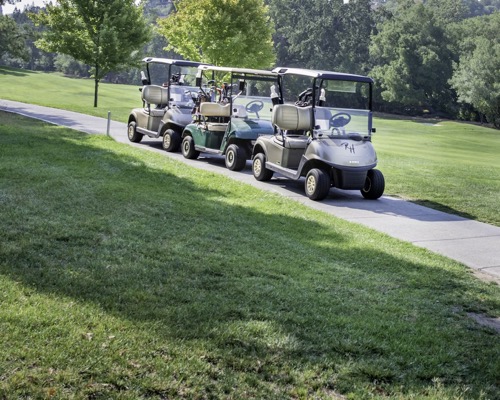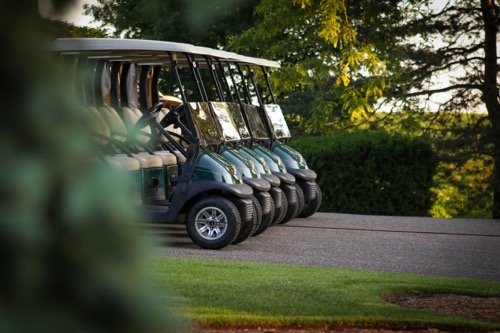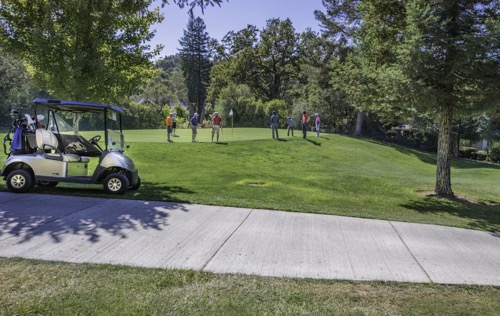A golf cart is a small vehicle designed for the sole purpose of transporting golfers and their equipment around a golf course. Golf carts are motorized and typically electric powered. They have become ubiquitous at golf courses worldwide as an efficient means of getting around the course during a round of golf. Golf carts come in a variety of models and styles, from basic two-seaters to luxury carts with upgraded seating and features.
In this guide, we will explore just how fast golf carts are capable of traveling. Golf carts are not high-performance vehicles, but there is some variation in top speeds depending on the cart’s motor, battery pack, drivetrain, and other factors. We want to find out what the typical stock top speed is for a golf cart, as well as how aftermarket modifications can impact maximum speed. This information will be useful for golfers looking to purchase a golf cart, either for recreational or competitive purposes. Knowing the speed capabilities can help choose the right golf cart and determine if any customizations are desirable.
1. How Golf Carts Work

The power source for most golf carts is an electric battery pack that provides energy to an electric motor. The motor then turns the wheels via a direct drive or gear-reduced transmission. This drivetrain from batter pack to motor to wheels is what propels the golf cart forward.
The key factors that impact the top speed of a golf cart are the electric motor, the battery pack, and the drivetrain. More powerful motors with higher horsepower ratings can attain faster speeds. Lithium-ion battery packs generally provide more power and faster acceleration than older lead-acid packs. And drivetrains with gear reductions and differential tuning can be optimized for speed rather than just basic function.
Upgrading any of these components can potentially increase the speed of a golf cart. More voltage to the motor, a more efficient battery back, and mechanical adjustments to the gears and transmission can eke out faster speed from a golf cart. But even stock golf carts have a range of top speeds based on their factory motor, batteries, and drivetrain. We will explore those stock speed ratings as well as customization options in the following sections.
2. Top Speeds of Different Brands and Models of Golf Carts

There are a few major manufacturers of golf carts that produce standard cart models found at most golf courses. These mainstream brands include Club Car, EZGO, Yamaha, and Polaris. Within each brand there are usually a few models that have different speed capabilities.
The basic two-seater golf carts from the major brands generally have top speeds in the 10 to 15 mph range. For example, the base model Club Car Precedent can reach a maximum speed of 12 mph. EZGO’s TXT model also has a top speed of 12 mph in its standard configuration. Yamaha’s Drive2 and Drive2 QuieTech golf carts top out at 12 and 13 mph respectively.
There are also specialty golf cart models focused on either lower speed or higher speed capabilities. On the lower end, some carts max out at 8-10 mph to provide a safer and more controlled ride. These include the Club Car Cavalier and Yamaha’s Early Drive models designed for younger golfers. At the high speed end, brands offer performance models with upgraded components and speed governors removed. Yamaha’s Gas G29 cart can reach 19 mph, while Club Car’s Precedent High Speed model hits 25 mph as optimized from the factory.
Aftermarket modifications can push the speed even higher through motor and battery upgrades. But standard golf cart models from the major brands typically fall in the 10 to 15 mph top speed range.
3. Ways to Increase the Top Speed of Golf Carts

While stock golf cart speeds are relatively modest, there are a variety of aftermarket modifications that can unlock greater speed potential. Upgrading the motor, the battery pack, and the drivetrain can improve acceleration and increase top speed.
More powerful motors, usually rated at a higher horsepower or voltage, can be swapped into a golf cart to provide more torque and power. High speed motors from third party manufacturers like NetGain or Mars Electric can add several mph to the cart’s capabilities. A multi-stage advanced DC motor system from IQ System or Kinetik can boost speed even further for those seeking high performance carts.
Switching out the standard lead-acid battery pack for a lithium-ion pack also lifts speed limits. Lithium-ion packs offer more power density and current flow to the motor, supporting increased speed. They are lighter weight than lead-acid as well, further improving acceleration. Major lithium pack brands like Trojan or U.S. Battery can be installed as replacements.
Drivetrain modifications like gear ratio changes, advanced controller systems, and torque converters can maximize speed output from the upgraded motor and batteries. Lower geared ratios force more rpm out of the motor at a given wheel speed. Programmable controllers can adjust throttle response and governor limits. And torque converters optimized for racing applications prioritize speed in their internal mechanism designs.
With the right combination of modifications, it’s possible to turn a sedate golf cart into a racing machine capable of significantly higher speeds. But speed comes at the cost of handling, safety, and drivability, so higher performance carts require expert design and integration.
Frequently Asked Questions about how fast golf carts can go
Q: What is the average top speed of a standard golf cart?
A: Most standard factory model golf carts have a top speed in the range of 10-15 mph. For example, popular gas and electric models from Club Car, EZGO, and Yamaha often top out at around 12-13 mph in their stock configurations. These speeds are fast enough for safe transportation around a golf course without excessive speed.
Q: What factors affect how fast a golf cart can go?
A: The top speed of a golf cart depends on several key components – the electric motor, battery pack, drivetrain, and speed governor. More powerful motors, higher voltage batteries, optimized gear ratios, and removed governors can all contribute to higher maximum speeds. Condition, terrain, and weight load also impact speed capabilities.
Q: How fast can specialty or high-performance golf carts go?
A: Custom carts built for speed or high-performance models optimized by manufacturers can reach speeds of 18-25 mph or more. For example, Yamaha’s Gas G29 cart has a top speed of 19 mph. Club Car’s Precedent High Speed model hits 25 mph from the factory. Aftermarket upgrades can push the speed even higher.
Q: What upgrades can increase the top speed of a golf cart?
A: Common upgrades include installing higher voltage motors, switching to lithium-ion battery packs, lowering gear ratios, adding high-speed controllers, and removing the speed governor. Combinations of these modifications when properly installed can add 5-15 mph to a cart’s top speed in some cases.
Q: Are there golf carts that go faster than 25 mph?
A: Yes, though at this point the carts become highly customized and optimized for racing rather than regular use. Professionally modified carts with upgraded motors, batteries, and drivetrains can reach speeds of 30-40+ mph. However, this comes at the expense of stability, safety, and drivability.
Q: What are the fastest production golf cart models available?
A: Some of the fastest stock golf carts are the Club Car Precedent High Speed (25 mph), Melex 252 (26 mph), Melex 512 Gas (27 mph), and Yamaha Gas G29 (19 mph). Cart builders like AGT offer custom carts that can exceed 30 mph from the factory as well.
Q: What governs the top speed of most golf carts?
A: Most golf carts have a speed governor that electronically limits the top speed to a preset level, usually in the 10-15 mph range. Removing or adjusting the speed governor allows a cart to reach faster speeds, though this affects insurance and compliance considerations.
Final Thoughts
In exploring the top speeds of golf carts, we’ve seen that there is a wide range depending on the stock model and configuration. Basic golf carts from major manufacturers like Club Car and EZGO generally have maximum speeds of 10-15 mph. This is sufficient for safe transportation around a golf course without excessive speed. Specialty carts designed for younger drivers or that prioritize stability have even lower top speeds around 8-10 mph.
On the higher end, optimized carts from the factory or specialty high-speed models can reach up to 19-25 mph thanks to performance components and removed governors. Further aftermarket modifications like motor, battery, and drivetrain upgrades can push maximum golf cart speeds even higher, though often at the expense of stability, drivability, and safety at this point.
Golf cart speeds are also dependent on terrain, load, and condition. The speeds discussed are optimal maximums on level ground under ideal circumstances. Real-world conditions impose further limits. Nonetheless, this overview gives a reasonable picture of how fast standard and modified consumer golf carts can go. Golfers can use this knowledge to select a golf cart well-suited to their needs based on the speed capabilities.
Enjoyed this guide of how fast can a golf cart go? Then be sure to check out our other golf guides.